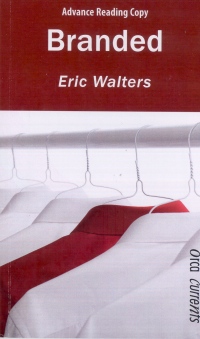| ________________
CM . . . . Volume XVI Number 25. . . .March 5, 2010. 
 |
Branded. (Orca Currents).
Eric Walters.
Victoria, BC: Orca, 2010.
109 pp., pbk. & hc, $9.95 (pbk.), $16.95 (hc.).
ISBN 978-1-55469-267-5 (pbk.), ISBN 978-1-55469-268-2 (hc.).
Grades 6-10 / Ages 11-15.
Review by Crystal Sutherland.
****/4
Reviewed from Advance Reading Copy.
|
| |
|

excerpt:
“We’ll try to make the student population aware of world issues. We’ll try to think globally and act locally,” he said.
I wasn’t sure what that meant, but I figured I’d learn that too.
“So, changing subjects, what do you think of the new school uniforms?” Mr. Roberts asked.
I hadn’t seen that coming.
“I’m not asking for state secrets,” he said. He must have read something in my expression. “I just want to know your opinion.”
“They’re just uniforms,” I said. “No big deal”
“From what I gather a lot of people thing it is a big deal.”
“Some people make a big deal out of nothing,” I said.
“And some people make nothing out of a big deal.”
“What?”
“Sometimes things that really do matter aren’t seen as being important. The secret is to know what counts and what doesn’t.”
Branded takes place in a junior high where Ian, Julia and Oswald are friends and classmates and Mr. Roberts is principal and teacher. The book, written from the perspective of Ian, a 13-year-old boy and good student, opens in Ians Social Justice class, created and taught by the school principal, Mr. Roberts. The school has been chosen for a pilot project testing school uniforms in public schools. Not a single student, aside from oddball Oswald, likes the idea of uniforms, but the principal stands firm and the uniforms are simply nonnegotiable. Ian, Oswald, and Julia, the school president, work to find reasons why the new uniforms are a bad idea.
Not until the day the gym is filled with uniforms of all sizes does Ian find a good reason to not have uniforms. In examining the labels, Ian finds a symbol that is familiar but that he does not understand. He and Oswald head to the computer lab and discover the symbol is the name of the brand third on a list of the worst sweatshop offenders. If students do not show up to school in uniform on Monday, they’ll be suspended, but Ian can’t ignore the sweat-shop origins of the uniforms. Faced with tough decisions, they look at the facts and the options available to them and, after careful consideration and evaluation, decide what action needs to be taken.
The novel is fast-paced and packed with thought-provoking questions as well as humour. Ian is a perceptive, likeable, and intelligent narrator who demonstrates the importance of critical thinking and checking the factuality of information before accepting it as truth. The use of Wikipedia and the quality of its contents are addressed. Critical thinking skills are well modelled, applied in ways relevant to the intended reader, and encouraged throughout the novel without taking away from the plot.
The use of social media in organizing events and expressing opinions, as well as their shortcomings, could provoke interesting discussions on etiquette and the Internet. The main characters discuss success and failures using social media for various purposes, again providing numerous opportunities for discussion and activities.
It is interesting that the only female who plays an important part in Branded is Julia, school president and one of the top students. Given that she is such a strong character and good role model, it was surprising that, when learning they will soon have school uniforms (before the issue of sweatshops appears), Julia quickly becomes frustrated and tells Ian it is his responsibility to find a way school uniforms can be avoided.
It is a bit cliché that both of Ian’s parents are lawyers and he is the best ‘thinker’ of the three friends. Ian's concerns over the uniforms, in the end, do not worry him as much as how Julia will react if Ian does not find a way to avoid school uniforms. Julia is not really very concerned about how the uniforms affect the students’ freedom to express themselves through their clothing choice. Ian tells his father that Julia just “doesn't like being told what to do.” Julia and Ian both believe that school uniforms would be a bad idea, but for very different reasons. Ian is a critical thinker and fully capable of building a strong argument while Julia is an excellent speaker who can inspire others to join a cause. Branded does an excellent job showing how people who want the same things, sometimes for very different reasons and with very different skills and personalities, can still work together to achieve a goal.
The book’s cliff-hanger ending, which could be irritating to some readers, provides a great jumping-off point for discussions about social justice, acceptable student behaviour, and the impact even one seemingly insignificant person can have when faced with a dilemma or issue that would be easy to ignore but is too important to cast aside. Branded is an inspiring and empowering read for youth living in the information age.
Highly Recommended.
Crystal Sutherland, who holds a Masters degrees in Literacy Education and Library and Information Science, lives in Halifax, NS.

To comment on this title or this review, send mail to
cm@umanitoba.ca.
Copyright © the Manitoba Library Association. Reproduction for personal use is permitted only if this copyright notice is maintained. Any other reproduction is prohibited without permission.
NEXT REVIEW |
TABLE OF CONTENTS FOR THIS ISSUE- March 5, 2010.
AUTHORS |
TITLES |
MEDIA REVIEWS |
PROFILES |
BACK ISSUES |
SEARCH |
CMARCHIVE |
HOME |
